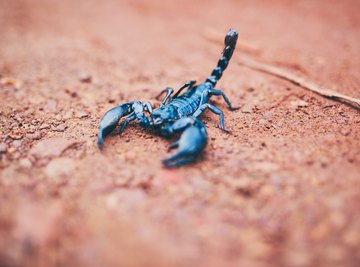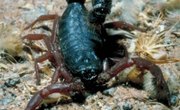
Scorpions are one of the world’s most ancient land invertebrates. They feed on any small prey that comes their way, including other scorpions. They can live for long periods without food or water, and have established themselves in many different environments. Because of the discovery of new species and differences in classifying methods, entomologists and taxonomists disagree on the exact number of scorpion species in the United States. There are at least 80 species, several of which are native to Colorado.
Family Buthidae: Centruroides Vittatus: Striped Bark Scorpion
The striped bark scorpion is the most common species in the U.S. It reaches 2.75 inches (7 cm) in length, and has two broad stripes down the length of its back. These scorpions inhabit the southern part of the state; they live under rocks, on trees, on fence posts and in buildings. Their venom has a low toxicity, and usually produces a sting with some swelling. However, reactions to scorpion bites may vary due to individual sensitivity or allergies.
Family Caraboctonidae: Hadrurus Spadix: Northern Desert Hairy Scorpion
This is the largest scorpion in the U.S., reaching up to 6 inches (15 cm). Its size enables it to add small mice, lizards and snakes to its diet. These scorpions have broad black backs and yellow heads. They are burrowers, and live on the west slope of the Rocky Mountains in Colorado. Their venom is not very toxic to humans, but may cause strong reactions in some individuals.
Family Vaejovidae: Genus Paruroctonus: Boreus and Utahensis

Genus Paruroctonus is the largest scorpion genus in the U.S. Two of its species are native to Colorado: boreus, the northern scorpion, and utahensis, the eastern sand scorpion. Like most species of this genus, these scorpions are very similar to one another. They both reach 1.5 to 2 inches (4 to 5 cm) in length, and have a pale yellow color. Their venom is not lethal to humans. The northern scorpion inhabits higher elevations, while the eastern sand scorpion prefers the sandy regions of the Colorado plateau.
Family Vaejovidae: Genus Serradigitus: Wupatkiensis
Wupatkiensis is a rare mountain scorpion that inhabits the western uplands of the state. It is one of 24 species of the genus Serradigitus, whose members are differentiated by the elongated formation of their pedipalp, or hand, and the size and shape of the teeth of the pectine, which is a comb-like sense organ located on the scorpion’s underside. Their venom is not considered lethal to humans.
Family Vaejovidae: Genus Vaejovis: Coahuilae, Spinigerus and Russelli

Vaejovis coahuilae, or the lesser stripetail scorpion, lives in habitats ranging from desert flats to mountain pine forests. It reaches lengths of 1.25 to 2 inches (3.5 to 5.5 cm). Its sting is painful, but typically has no medical side effects. Vaejovis springerus is a closely related species that can reach 2.75 inches (7 cm) in length. Vaejovis russelli is a widespread but uncommon species that grows to 2 inches (4 to 5.5 cm), and has a brownish-yellow color and red fingers. This burrowing scorpion lives beneath rocks, or under the base of plants. Its sting is not considered lethal to humans.
References
Resources
About the Author
Wayne Shirey is a senior control engineer with Southern Synergy who began writing nonfiction in 2007. His articles have appeared in several reference works, including "Great Events from History" and "The Encyclopedia of American Immigration." He holds a Bachelor of Science in engineering from the University of Alabama in Huntsville.
